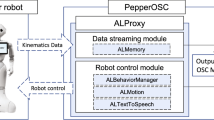Abstract
The current concept of robots has been greatly influenced by the image of robots from science fiction. Since robots were introduced into human society as partners with them, the importance of human–robot interaction has grown. In this paper, we have designed seven musical sounds, five of which express intention and two that express emotion for the English teacher robot, Silbot. To identify the sound design considerations, we analyzed the sounds of robots, R2-D2 and Wall-E, from two popular movies, Star Wars and Wall-E, respectively. From the analysis, we found that intonation, pitch, and timbre are dominant musical parameters to express intention and emotion. To check the validity of these designed sounds for intention and emotion, we performed a recognition rate experiment. The experiment showed that the five designed sounds for intentions and the two for emotions are sufficient to deliver the intended emotions.
Similar content being viewed by others
References
Lee C, Lee GG (2007) Emotion recognition for affective user interfaces using natural language dialogs. In: Proceedings of the IEEE international symposium on robot and human interactive communication, Jeju, pp 798–801
Berg J, Wingstedt J (2005) Relations between selected musical parameters and expressed emotions: extending the potential of computer entertainment. In Proceedings of the international conferences on advances in computer entertainment technology, Valencia, pp 164–171
Baumgartner T, Lutz K, Schmidt CF, Jancke L (2006) The emotional power of music: how music enhances the feeling of affective picture. Brain Res 1075: 151–164
Schubert E (2004) Modeling perceived emotion with continuous musical features. Music Percept 21(4): 561–585
Juslin PN, Sloboda JA (2001) Music and emotion. Oxford University Press, New York
Nakanishi T, Kitagawa T (2006) Visualization of music impression in facial expression to represent emotion. In Proceedings of the Asia–Pacific conference on conceptual modeling, Hobart, pp 55–64
Jee E-S, Kim CH, Park S-Y, Lee K-W (2007) Composition of musical sound expressing an emotion of robot based on musical factors. In Proceedings of the IEEE international symposium on robot and human interactive communication, Jeju, pp 637–641
Lerdahl F, Jackendoff R (1983) A generative theory of tonal music. MIT Press, Cambridge
Meyer LB (1956) Emotion and meaning in music. University of Chicago Press, Chicago
Pratt CC (1948) Music as a language of emotion. Bull Am Musicol Soc 11(1): 67–68
Kivy P (1999) Feeling the musical emotions. Br J Aesthet 39: 1–13
Levinson J (1982) Music and negative emotion. Pac Philos Q 63: 327–346
Cook N, Dibben N (2001) Musicological approaches to emotion. In: Juslin P, Sloboda H (eds) Music and emotion: theory and research. Oxford University Press, New York, pp 45–70
Feld S (1982) Sound and sentiment: birds, weeping, poetics, and song in Kaluli expression. University of Pennsylvania Press, Philadelphia
Becker J (2001) Anthropological perspectives on music and emotion. In: Juslin P, Sloboda H (eds) Music and emotion: theory and research. Oxford University Press, New York, pp 135–160
Blood AJ, Zatorre RJ, Bermudez P, Evans AC (1999) Emotional responses to pleasant and unpleasant music correlate with activity in paralimbic brain regions. Nat Neurosci 2(4): 382–387
Juslin PN, Vastfall D (2008) Emotional responses to music: the need to consider underlying mechanisms. Behav Brain Sci 31: 556–621
Livingstone SR, Thompson WF (2009) The emergence of music from the theory of mind. Music Sci 10: 83–115
Hevner K (1935) Expression in music: a discussion of experimental studies and theories. Psychol Rev 42: 186–204
Hevner K (1935) The affective character of the major and minor modes in music. Am J Psychol 47(4): 103–118
Hevner K (1936) Experimental studies of the elements of expression in music. Am J Psychol 48(2): 103–118
Hevner K (1937) The affective value of pitch and tempo in music. Am J Psychol 49(4): 621–630
Juslin PN (2000) Cue utilization in communication of emotion in music performance: relating performance to perception. J Exp Psychol 16(6): 1797–1813
Garbrielsson A, Lindstrom E (2001) The influence of musical structure on emotional expression. In: Juslin P, Sloboda H (eds) Music and emotion: theory and research. Oxford University Press, New York, pp 223–248
Juslin PN, Laukka P (2003) Communication of emotions in vocal expression and music performance: different channels, same code?. Psychol Bull 129(5): 770–814
Schubert E (2004) Modeling perceived emotion with continuous musical features. Music Percept 21(4): 561–585
Jee E-S, Cheong Y-J, Park S-Y, Kim CH, Kobayashi H (2009) Composition of musical sound to express robot’s emotion with intensity and synchronized expression with robot’s behavior. In: Proceedings of the IEEE international symposium on robot and human interactive communication, Toyama, pp 369–374
Russel JA (1980) A circumplex model of affect. J Pers Soc Psychol 39: 1161–1178
Author information
Authors and Affiliations
Corresponding author
Rights and permissions
About this article
Cite this article
Jee, ES., Jeong, YJ., Kim, C.H. et al. Sound design for emotion and intention expression of socially interactive robots. Intel Serv Robotics 3, 199–206 (2010). https://doi.org/10.1007/s11370-010-0070-7
Received:
Accepted:
Published:
Issue Date:
DOI: https://doi.org/10.1007/s11370-010-0070-7




